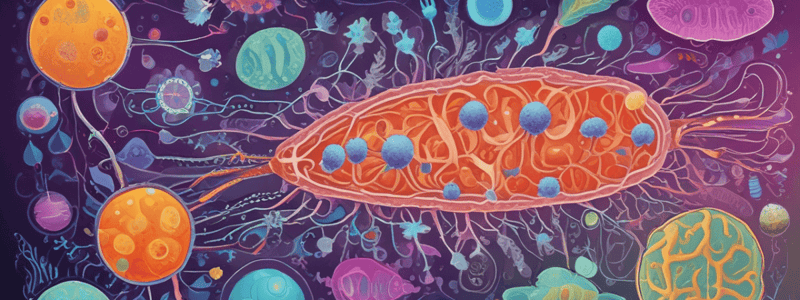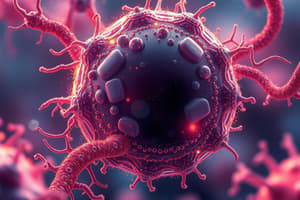Podcast
Questions and Answers
Which of the following is present in prokaryotes but not eukaryotes?
Which of the following is present in prokaryotes but not eukaryotes?
- nucleus
- spliceosomes
- mitochondria
- simultaneous transcription and translation (correct)
The nitrogen bases in DNA are bonded to the:
The nitrogen bases in DNA are bonded to the:
- ribose
- hydrogen
- phosphate
- deoxyribose (correct)
What is the primary role for antibodies in resistance to bacterial infection?
What is the primary role for antibodies in resistance to bacterial infection?
- Activation of the alternative complement pathway (correct)
- Promoting cell lysis through perforin
- Production of toxins
- Inhibiting DNA replication
Which selective medium is used for Salmonella?
Which selective medium is used for Salmonella?
Which cell type is involved in the predominant hypersensitivity reaction involving IgE?
Which cell type is involved in the predominant hypersensitivity reaction involving IgE?
Which molecules can distinguish self from pathogen?
Which molecules can distinguish self from pathogen?
The microorganism could use CO2 a carbon source and inorganic chemical compounds as an energy and electron source is
The microorganism could use CO2 a carbon source and inorganic chemical compounds as an energy and electron source is
The compound that lacks the presence of phosphates in the structure of a bacterial Gram positive wall is
The compound that lacks the presence of phosphates in the structure of a bacterial Gram positive wall is
The microorganism that has no ability to synthesize a growth factor is
The microorganism that has no ability to synthesize a growth factor is
The swarming of Proteus bacteria inhibit if the concentration of agar is
The swarming of Proteus bacteria inhibit if the concentration of agar is
Nitrosomonas is
Nitrosomonas is
Which one of the following is most responsible for the nature of the lesion on the foot caused by Staphylococcus aureus?
Which one of the following is most responsible for the nature of the lesion on the foot caused by Staphylococcus aureus?
The blood culture was negative. What is the best explanation for this?
The blood culture was negative. What is the best explanation for this?
What types of inhibitors affect the work of enzymes?
What types of inhibitors affect the work of enzymes?
Which of the following inhibits DNA gyrase?
Which of the following inhibits DNA gyrase?
Which of the following antimicrobial drugs is synthetic?
Which of the following antimicrobial drugs is synthetic?
Which of these situations would be appropriate for treatment with a narrow-spectrum antimicrobial drug?
Which of these situations would be appropriate for treatment with a narrow-spectrum antimicrobial drug?
Which of the following is not a type of β-lactam antimicrobial?
Which of the following is not a type of β-lactam antimicrobial?
Which of the following resistance mechanisms describes the function of β-lactamase?
Which of the following resistance mechanisms describes the function of β-lactamase?
The etiology of the sore throat would have been best determined by:
The etiology of the sore throat would have been best determined by:
Virulence refers to:
Virulence refers to:
What laboratory test would be most likely to confirm the diagnosis of Lyme disease?
What laboratory test would be most likely to confirm the diagnosis of Lyme disease?
An F-pilus is essential for:
An F-pilus is essential for:
Which of the following statements about gene expression is false?
Which of the following statements about gene expression is false?
Which of the following is not characteristic of eukaryotic gene expression?
Which of the following is not characteristic of eukaryotic gene expression?
Which laboratory test for diagnosing Lyme disease involves detecting the presence of specific DNA sequences?
Which laboratory test for diagnosing Lyme disease involves detecting the presence of specific DNA sequences?
Which method is least likely used to determine viral etiology?
Which method is least likely used to determine viral etiology?
Flashcards are hidden until you start studying
Study Notes
Competitive Exams for the Academic Year 2021-2022
Question 1
- Chemoautotrophic organisms can use CO2 as a source of carbon and inorganic chemicals as a source of energy and electrons.
- These organisms can be classified into three types: chemoautotrophic lithotrophic, chemoautotrophic non-lithotrophic, and mixotrophic.
- The correct answer is chemoautotrophic lithotrophic.
Cell Wall Structure
- Teichoic acid is absent in the cell wall structure of Gram-positive bacteria.
- The correct answer is teichoic acid.
Nutrient Requirements
- Some microorganisms are unable to synthesize growth factors.
- The correct answer is oxytrophic non-autotrophic.
Bacterial Motility
- The movement of Proteus bacteria stops at an agar concentration of 5%.
Nitrosomonas
- Nitrosomonas is a chemoautotrophic non-lithotrophic organism.
Question 2
- There are several types of inhibitors that affect enzyme activity, including competitive, non-competitive, uncompetitive, and suicide inhibitors.
Question 3
- Staphylococcus aureus produces coagulase, which is responsible for the formation of abscesses on the skin.
- The correct answer is coagulase.
Blood Culture
- A negative blood culture result may be due to the presence of antibiotics, which can inhibit the growth of bacteria.
- The correct answer is the presence of antibiotics.
The Etiology of Sore Throat
- The etiology of sore throat can be determined by throat culture, ASO titer, or throat antigen detection.
Virulence
- Virulence refers to the ability of bacteria to cause disease in a susceptible host.
Lyme Disease
- The diagnosis of Lyme disease can be confirmed by Borrelia burgdorferi immunoassay, immunoblot, or PCR of CSF.
Spore Formation
- Spore formation involves several stages, including sporulation, germination, and outgrowth.
F-pilus
- F-pilus is essential for chromosome transfer by conjugation.
Gene Expression
- More than one RNA polymerase can transcribe a specific gene at a given time.
- More than one ribosome can translate a specific transcript at a given time.
- Translation begins at a site called a terminator.
Eukaryotic Gene Expression
- Eukaryotic gene expression involves the addition of a 5' cap and a poly A tail to the mRNA.
- Introns must be removed to create the mRNA that is translated.
- Translation begins at the first AUG.
Multiple Choice
- Spliceosomes are present in eukaryotes but not prokaryotes.
- The nitrogen bases in DNA are bonded to the deoxyribose.
Short Answer
- Conjugation involves the transfer of DNA from one bacterium to another through direct cell-to-cell contact.
- Transformation involves the uptake of free DNA by a bacterium.
- Transduction involves the transfer of DNA from one bacterium to another through a bacteriophage.
- Direct tests involve the detection of bacterial antigens or nucleic acids, while indirect tests involve the detection of antibodies or other immune responses.
Additional Questions
- Microbial activity level can be determined by measuring the rate of substrate utilization or the production of metabolic byproducts.
- The carbon cycle in land and microorganisms differs in terms of the sources of carbon and the types of organisms involved.
- There is no significant difference between the water cycle in land and the water cycle on the mainland.
Question 13
- Ciprofloxacin inhibits DNA gyrase.
- Sulfanilamide is a synthetic antimicrobial drug.
- Narrow-spectrum antimicrobial drugs are appropriate for treating specific infections, such as strep throat caused by Streptococcus pyogenes.
- Glycopeptides are a type of β-lactam antimicrobial.
- β-lactamase resistance involves the degradation of β-lactam antibiotics.
Question 14
- The outer membrane of Gram-negative bacteria is a selective target for antibacterial drugs.
- An example of an antimicrobial compound that targets this structure is polymyxin.
Studying That Suits You
Use AI to generate personalized quizzes and flashcards to suit your learning preferences.




